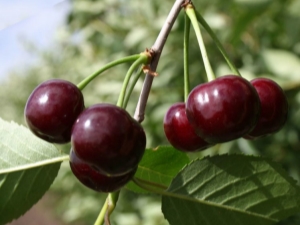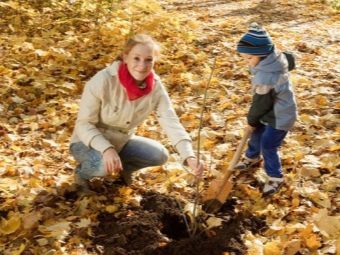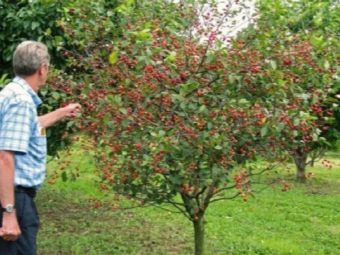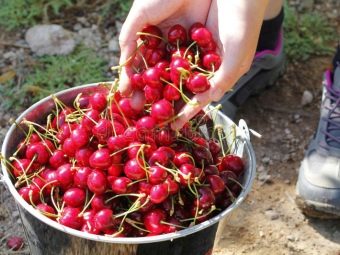Cherry "Youth": the description and cultivation of the variety

Among the seasonal berries, cherry has always been highly respected, which is why cherry trees are present in almost every garden.Thanks to the work of breeders, the range of crops has expanded significantly, and gardeners and gardeners have the opportunity to cultivate no less productive hybrid plants. These varieties should include the Molodezhnaya cherry.
Characteristic
Such a berry as a cherry is a source of beneficial vitamins, so it is consumed fresh and canned. In order to make it easier for gardeners to grow such a crop, varieties were bred that, despite their unpretentious care, are able to produce an excellent harvest during the season. Among these plants can be attributed to the Molodezhnaya cherry.
The hybrid can be found on most garden plots not only in southern latitudes, but also in the central regions, since it stands out for good winter hardiness. According to reviews of gardeners, this variety can be cultivated even in the Urals.
The Molodezhnaya Cherry was bred by Russian breeders and registered in the State Register in 1993. According to the recommendations, the hybrid is zoned for the Central region. The culture was obtained by crossing “Vladimirskaya” and “Lubskaya” cherries. The tree does not stand tall, its average value is at the level of two meters.
The rounded crown has an average thickness, the branches of the culture develop slightly lowered to the ground, which is a significant advantage during the berry harvest period. The tree belongs to the bushy varieties, due to which its decorative quality increases. In addition, the culture does not take up much space in the garden.
The plant is capable of fruiting at about the third year of life and maintains high yields for 20 years. On average, from one tree you can get more than 10 kilograms of cherries. The trunk and branches of “Youth” cherries have a brown color, the foliage grows slightly oval, saturated green color, the reverse side of the sheets, as a rule, has a lighter shade. The inflorescences are formed from 3-4 flowers in the shape of an umbrella. A hybrid blooms with whole flowers, the phase of flowering occurs most often at the end of May.
The formation of blooming ovaries occurs already in a one-year-old sapling, all the buds are flowers, except the apical. This feature causes a rather unusual appearance of the tree after picking berries - during this period it looks pretty bare.
The size of the pistils and stamens of cherries is almost the same, due to which pollination is carried out even in closed flowers. Despite its origin, the plant is an excellent pollinator for other berry crops.
The hybrid is self-fertile, so that even when planting a single cherry of this variety on the plot, you can count on a harvest of juicy berries in summer. As a rule, trees are planted at a distance of 2-3 meters from each other. Such a planting scheme contributes to good crop yields, due to the occurrence of cross-pollination by bees that will fly to the flowering area.
Excellent neighbors for Molodezhnaya Cherries are maternal varieties, in addition, pollinators such as Shubinka, Frost Cherry and other plants with close flowering periods.
Hybrid is a crop related to medium-term varieties of ripening. Usually the harvest comes in July. The berries of the cherry are large, reaching 100 mm in diameter, the mass of one is about 5 grams. Cherry is fleshy, stands out burgundy, inside there is a bone. The juice has a purple color, the flesh is remarkable for its slight sourness.
The demand for a hybrid is due to the following positive characteristics:
- the culture bears fruit well without additional pollinating plants;
- the tree is frost resistant;
- with the right agrotechnology, Molodezhnaya will produce a regular and large crop of berries;
- planting and caring for the plant does not include any complex tasks;
- in addition, the plant tolerates seasonal drought well.
Like any other berry crop, the variety has disadvantages. The main disadvantage of cherries is their low immunity to fungal diseases.
Landing
To ensure a good harvest of cherries in the future, the first priority will be a competent selection of seedlings. It is necessary to give preference to annual or biennial plants that have reached a height of 70 centimeters or more. It is these cultures that most quickly adapt to new conditions. To facilitate the task of caring for a plant, you should purchase a two-year sapling of cherry, which will already have a crown. It is better to buy trees that have foliage, by green mass it will be easier to determine how healthy the plant is. As for the roots, their length should be at least 10 centimeters, in addition, they should not be signs of damage or disease.
Rooting culture in the garden can be carried out in spring or autumn. Each period has its positive and negative sides. When planting a seedling at the beginning of the year, it is quite difficult to determine the duration of the work, since it is very important to plant material before the onset of the growing season in the crop. In addition, an important time is the right time. It is necessary that the thermometer indicators no longer descend to the zero mark. In most cases, favorable weather conditions occur in April.
As for the readiness of the land, you can verify its condition with the help of an ordinary garden shovel;
Some gardeners prefer spring planting based on the following points:
- soil in the spring is maximally enriched with moisture;
- during the summer months, a young sapling will be able to sufficiently adapt to new conditions and grow stronger;
- You can prepare a site for cherry in advance and monitor its development throughout the summer season.
In the middle lane, the autumn planting of cherries is usually held in September. It is believed that one or two months will be enough for the plants to allow the roots to develop and adapt. The effectiveness of this short term is due to the fact that in the fall the culture will be at rest, therefore the maximum concentration of force will fall on the formation of a powerful root system. In spring, the plant concentrates most on growth. The popularity of the autumn planting of cherries is explained by the possibility of natural watering with precipitation, as well as the free time of gardeners, since the main activities on the site are already completed or are coming to an end.
After the selection of planting material and the landing period, attention should be paid to the choice of a place for the cultivation of "Youth" cherries. Hybrid will need a sunny and windless plot, preferably in the southern part of the garden. An important nuance is the level of groundwater. Optimally, it takes place at the level of one and a half meters. From planting in the lower garden should be abandoned, if the terrain is hilly, it is better to plant a cherry on a hill. This variety grows well in sandy soils with normal acidity.
Organic fertilizers and mineral supplements should be added to the seedling wells. After rooting, the plants will also need additional feeding, but caution should be exercised with nitrogen-containing drugs, as they provoke the growth of green mass in the culture. And it is a kind of bait for insect pests. Planting is performed as follows:
- the depth of the cherry pit should be at least 50 centimeters, with a diameter of about 80 centimeters;
- of fertilizers, it is better to introduce humus, wood ash, potash saltpeter;
- at the bottom, a hill is formed from the ground where the sapling goes;
- after the roots are straightened by the plant, it is covered with soil and tamped with soil;
- watering is carried out with settled water;
- from above the ground is mulched with peat or humus.
It is best to grow cherries, apples or grapes in the neighborhood of Molodezhnaya. The hybrid does not transfer the neighborhood with the currant very well, therefore such a scheme for placing plants on the site should be abandoned.
Care
Competent agricultural technology is the key to a great harvest. Care culture includes the following mandatory work:
- soil treatment;
- watering;
- pruning;
- soil fertilizer;
- preventive measures against diseases and pests;
- whitewashing the trunk;
- preparation for winter.
The land around the cherry must be weeded regularly and remove weeds. In the course of these works, one should rather carefully wield a garden tool, since some plant roots are located close to the surface. Loosening is mandatory after the planned crop irrigation, as well as after precipitation, because on the ground, when all the moisture is absorbed, a crust forms, which disrupts soil aeration. Soil mulching will be an excellent alternative to loosening, due to the fact that the layer of mulch will provide an opportunity to retain moisture and avoid the growth of weeds.
As mulch it is best to use organic matter, for example, straw or dry humus, which will also act as an additional fertilizer.
Cherry "Youth" well tolerates the heat and drought. However, in some phases of culture development, the introduction of moisture is mandatory. This applies to the period of flowering of the tree, active growth, as well as during the ripening of berries and in the autumn period when the foliage begins to fall. The optimal amount of moisture is 50 liters per 1m ² circle of the barrel. The most effective for cherries will be surface watering, and special grooves will be formed for its execution in the ring wheel. The introduction of moisture occurs in batches, as water is absorbed. In addition, unlike most horticultural crops, cherries can be watered with cold water from a well or hose.
Forming a plant is a must-have procedure for proper development. Usually work is carried out in the spring, before the first kidney has been hiccups. This time is chosen by chance, since it will take some time for the cherry tree to recover before the active growth phase in spring and summer. Pruning a young tree is carried out by cutting branches in such a quantity that there are about 10 pieces left on it, located in different directions. Places of cuts must be healed with garden broth.
In other seasons, branches remove the length of the cherry that exceeds half a meter, and old and diseased shoots are also removed. During fruiting, pruning of the crown should be carried out to ensure access of sunlight to hard-to-reach places. In the course of sanitary pruning, remote branches with signs of illness should be burned, and the work tool should be disinfected. For trees whose age exceeds 5 years, the crown is already molded more significantly - too large branches can be cut a meter or more. In addition, if the cherry is already above 2.5 meters, its crown must also be cut.
After planting for the first few years, the cherry will be fed by the substances that were introduced into the hole along with the plant. After two years, fertilizers are introduced as follows:
- once every 3-4 years the culture is fertilized with organic matter;
- once in 6–7 years, she will need mineral supplementation.
The technology of introducing beneficial microelements for young plants implies their concentration within the near-circle range, as for more mature cherry trees, it will be necessary to fertilize the entire area. In the spring, emphasis should be placed on nitrogen-containing compounds, they can be entered both in the dry and in the liquid state. Organic, such as manure, it is better to use as an infusion.
In the summer, it is useful to use herbal infusions to nourish, a good influence on the yield of cherries have infusion of nettle.In the formation phase of the ovaries, gardeners recommend spraying the culture with copper sulphate. As for the fall, at this time the plant will most likely be deficient in phosphorus and potassium. These substances will increase the capacity of the plant to future fruiting, as well as provide immunity to disease and resistance to frost.
Preventive measures associated with various ailments of culture, require regular inspection of green mass of the plant for signs of disease. If there are traces of a fungal infection on a cherry, infected shoots must be cut off, and spraying with antibacterial compounds should be performed. Most often, the plant affects moniliosis. Unfortunately, folk remedies for this disease does not exist, so the treatment is performed exclusively by chemical compounds. An effective remedy for gray rot will be a Bordeaux liquid.
To protect the culture from infection in the spring, it is sprayed with iron sulphate.
Damage to the cherry tree can cause aphid. The main sign of the appearance of an insect is twisted foliage. With a small amount of aphids on the plant, it is harvested by hand, and the foliage is burned. As preventive measures culture treated with soapy water. In winter, rodents can harm cherries, most often they are hares. To protect the trunk, special protective shields of mesh or thick rags are erected around it in the fall.
Cherries also need whitewash, usually work is carried out in spring and autumn. Spring whitewashing will protect the tree from sunburn and insects, and the autumn one - from diseases and rodents. Typically, the composition is processed stem and skeletal branches of the plant. For adult cultures, calcareous compositions are used, for young cherries, chalky whitewash is used. Due to the winter hardiness of the hybrid, it does not need any special preparatory work for the winter, it will be enough to perform sanitary pruning, whitewashing and digging the tree trunk.
Harvesting and Storage
Harvesting of cherries begins only after their full ripening, the work on gathering fruits that precede their ripening should not be done, since the berries do not have the ability to ripen on a tree. Cherry can be harvested by milking, tearing it off without a leg, but the shelf life in this form will be minimal, so the harvest will not be suitable for transportation. Cutting is considered a more efficient option. But still, the cherry is a stone fruit culture, which is not possible to keep fresh for a long time.
To extend its marketability and freshness for 2–3 weeks, you need to pick berries without any defects and damage, do not wash the entire harvest, and use boxes with gaps for air circulation as a container for storing berries. Typically, the container is disinfected, lined with paper and laid there with a layer of cherries no more than 5 centimeters. The harvest should be stored in this variant at a temperature not higher than + 4ºС.
On how to plant a cherry, see the following video.

















































